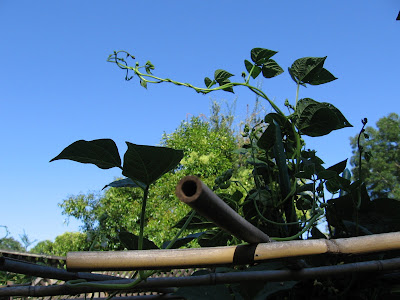

The great green machine is revving up. Above is the zucchini patch as of mid-June, a couple of weeks ago, and again as it is today. This is a row of three plants, rather close together. In the top photo you can see the lid of the sunken, plugged flower pot that serves as an irrigation reservoir. There is one next to each plant.
Planting History:
Variety: Green Racer zucchini
Source: Whole Foods (Sweetwater Nursery) seedlings
Seedlings planted out: May 10, 2009
First harvest: June 14, 2009
 These are the first few pickings in chronological order left to right. You can see that the earliest blossoms are brown and dry and the first couple of fruits are smaller and tapered toward the tip. Probably they didn't get fertilized (that's my theory, anyway) because the bees didn't get the press release. The news is out by now for sure. This past weekend there was a big bag of beautifully shaped zucchini in the fridge. Time for green soup!!! Who cares if the temperature is pushing 100 degrees -- summon up that old pioneer spirit.
These are the first few pickings in chronological order left to right. You can see that the earliest blossoms are brown and dry and the first couple of fruits are smaller and tapered toward the tip. Probably they didn't get fertilized (that's my theory, anyway) because the bees didn't get the press release. The news is out by now for sure. This past weekend there was a big bag of beautifully shaped zucchini in the fridge. Time for green soup!!! Who cares if the temperature is pushing 100 degrees -- summon up that old pioneer spirit.
 There's no recipe for green soup, just a general process. The ingredients change according to the seasons: winter is kale and chard and broccoli; summer is mostly zucchini. Here's a description based on this weekend's batch:
There's no recipe for green soup, just a general process. The ingredients change according to the seasons: winter is kale and chard and broccoli; summer is mostly zucchini. Here's a description based on this weekend's batch:1. Heat up a thin layer of good olive oil in a favorite soup pot.
2. Smash four or five cloves of peeled garlic, stir them around in the oil to infuse the flavor.
3. Saute chopped onion and celery -- enough to make a half inch layer on the bottom of the pot.
4. Add peeled, chopped carrots and potatoes -- as many as you feel like and have on hand. This batch has four big carrots and a couple of medium new red potatoes.
5. Stir it all around until coated with oil. Put lid on and let mixture soften up a bit.
6. Cover with vegetable broth -- homemade mushroom broth can't be beat. Let simmer to soften up the carrots and potatoes some more.
7. Add as much chopped zucchini as you can cram into the pot, along with any other greens you have around. This batch used the whole bag of zucchini -- about 10 lovelies of various sizes. It also includes the last few volunteer kale plants from a corner of the yard. This is the point to add any quicker cooking veggies you have on hand. Some chopped parsley is nice.
8. Add some cooked beans if you have them -- garbanzo or small white beans are great -- for extra heft and nutrition.
9. Simmer until everything is soft.
10. Put in the fridge to cool. It makes blending easier. If you have hungry people hanging around, go ahead and blend right away.
11. Eat some now.
 12. And freeze the rest. I take these little packages to work for lunch so often it causes comment. But I am unabashed. Green soup is nectar and ambrosia in one fragrant, sustaining brew, the elixir of life. H. loves the stuff so whenever he comes by he takes a couple home.
12. And freeze the rest. I take these little packages to work for lunch so often it causes comment. But I am unabashed. Green soup is nectar and ambrosia in one fragrant, sustaining brew, the elixir of life. H. loves the stuff so whenever he comes by he takes a couple home.













